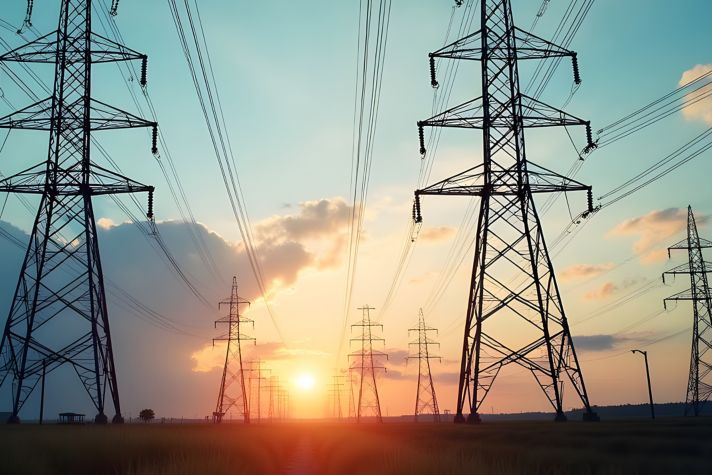What you will learn in this article:
- The benefits of energy diversification and why a beneficial mix matters.
- The role of hydrogen, liquefied natural gas (LNG), carbon capture technologies, battery energy storage solutions and energy management systems in the energy mix.
The world uses a lot of energy. It’s anticipated that energy demand will surge by 32% worldwide this year, with electricity needs projected to rise even more.1 This upswing in energy demand is a result of factors including economic development in emerging markets, rising power consumption from industry, the electrification of transport and the growth of AI data centers.2 An increase in demand can lead to energy shortages and disruptions, though, making access to more reliable, affordable and sustainable energy a priority.
Traditional fossil fuels make up a large percentage of the global energy mix. This reliance on traditional, often carbon-intensive energy sources may leave governments and businesses vulnerable to market volatility, supply chain issues, and environmental and geopolitical uncertainty. Also, continued dependence on fossil fuels without carbon-reducing processes makes it increasingly difficult to achieve carbon reduction and emission targets.
Energy producers need to reshape and diversify their energy mix, reducing dependence on traditional energy sources and helping to lessen carbon impact.
What is an energy mix?
An energy mix refers to the combination of various energy sources a country or region uses to meet its needs, including coal, natural gas, nuclear, wind and solar. By incorporating a diverse mix of energy sources, countries and communities can develop more resilient energy systems.
The global energy mix: Where are we now?
The world still relies heavily on traditional energy sources. By region, the energy consumption breakdown among major and emerging markets is:
Depending on a limited number of energy sources and suppliers can increase vulnerability to price volatility. Baseload supply also needs to be considered to avoid further grid instability.
The benefits of energy diversification
Resilience
Relying on one energy source can make a system vulnerable. A nation relying solely on coal, for example, could face significant power outages due to a disruption to the coal supply chain. Diversifying supply can reduce the impact of such disruptions, as other sources can pick up the slack.
Renewable energy sources such as solar and wind power can reduce dependence on traditional energy, but they are often intermittent, meaning output can fluctuate based on weather conditions and time of day. Combining these sources with more consistent forms of energy, including hydrogen or natural gas, creates a steadier energy supply. Energy storage systems are crucial for managing the intermittency of renewables.
Microgrids can also help improve resilience. Using digital technologies, sensors and software, they better match the supply and demand of electricity, in real time, while minimizing costs and maintaining the stability and reliability of the grid.
Cost and Risk Management
Organizations can achieve greater stability by spreading risks. By using a variety of energy sources including wind, solar, hydrogen and natural gas, economies can avoid extreme fluctuations in energy prices and the commercial impacts of grid disruptions. Including natural gas can be a cost-effective option, as it’s often more affordable than oil 7 and more readily available than some renewable sources.8
Helps Address Sustainability Goals
Incorporating low-emission energy sources can help meet cleaner energy goals. Renewable energy sources generate electricity with minimal or no greenhouse gas emissions. Pairing these renewable sources with traditional energy sources and energy storage can make these solutions more viable and help balance out intermittency.
The role of LNG, hydrogen and emerging technologies in energy diversification
Emerging Energy Sources: Hydrogen and Liquefied Natural Gas (LNG)
Emerging fuel sources like liquefied natural gas (LNG) and hydrogen have become major factors in the transition to clean energy, while bolstering energy security. They provide more readily available energy than renewables — especially in regions where the transition to renewables is less mature — and they offer lower-carbon alternatives to fossil fuels.
LNG is natural gas cooled to a liquid form, making it easier to store and ship, especially to locations without pipelines. LNG is considered a bridge fuel because it produces 40% less CO2 than coal and 30% less than oil when burned, while still offering reliability.8
Hydrogen is key to decarbonization and seasonal storage. According to the International Renewable Energy Agency (IRENA), hydrogen can decarbonize end uses where other options are less mature or more costly.9 Advances in hydrogen production, purification and distribution are enabling the growth of the hydrogen economy and accelerating carbon goals.
Carbon Capture
Since the refining sector accounts for approximately 15% of global carbon dioxide emissions,10 carbon capture technologies present significant energy efficiency opportunities to help minimize the environmental impacts of coal, natural gas and hydrogen energy production.
Battery Energy Storage, Microgrids and Distributed Energy Resources
Battery energy storage systems (BESS) and energy management systems (EMS) are designed to help industrial operators, power producers and utilities improve grid stability, increase revenue and meet peak demands without straining electrical systems. A BESS can be deployed alone or with a mix of energy generating assets to form a microgrid in front or behind the meter to support a site’s resilience in the face of unstable grids.
The right mix matters
An intelligent energy mix that incorporates innovative production processes, storage technologies, distributed energy resources and smart grids is essential for long-term energy security and allows for a more resilient energy system capable of adapting to a changing world.
Learn how Honeywell lower-carbon technologies are supporting energy security by downloading our latest eBook, “Strategies to Strengthen Global Energy Security.”
Sources:
1: Bloomberg New Energy Finance, "New Energy Outlook - BloombergNEF,” David Hostert, April 15, 2025. [Accessed June 5, 2025]
2: International Energy Agency, “Growth in global energy demand surged in 2024 to almost twice its recent average.” March 24, 2025. [Accessed June 18, 2025]
3: International Energy Agency, ”United States - Countries & Regions - IEA,” December 21, 2023. [Accessed June 5, 2025]
4: International Energy Agency, ”Europe – Countries & Regions - IEA,” December 21, 2023. [Accessed June 5, 2025]
5: International Energy Agency, ”Middle East – Countries & Regions - IEA,” December 21, 2023. [Accessed June 5, 2025]
6: International Energy Agency, ”India - Countries & Regions - IEA,” December 21, 2023. [Accessed June 5, 2025]
7: Stout, “Is BOE Still Relevant With Today's Commodity Prices? | Stout” Greg Scheig, March 14, 2024. [Accessed July 25, 2025]
8: National Grid, “What is liquefied natural gas?,” April 3, 2024. [Accessed June 18, 2025]
9: International Renewable Energy Agency, “Reaching Zero with Renewables,” September 2020. [Accessed June 18, 2025]
10: International Energy Agency, “Emissions from Oil and Gas Operations in Net Zero Transitions,” May 2023. [Accessed June 18, 2025]




